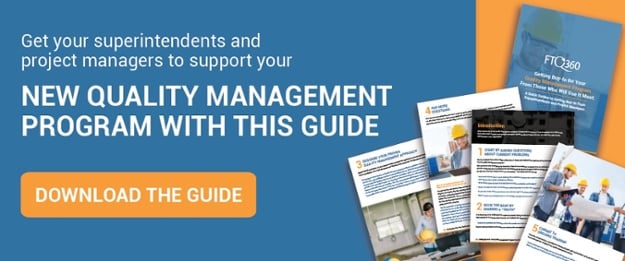
Implementing a new construction quality program is never as simple as introducing a modern system and having people immediately adopt it. In fact, you will probably face some hurdles before you even get to the point of rolling out new software or making a single change in your current quality control processes. However, actively taking steps to build consensus can help you overcome some of those barriers and even generate enthusiasm for shifting to a system that facilitates first-time quality.
In the construction industry, there are a lot of moving parts in every project, and multiple people with varying interests. Understanding the challenges each of these people face and the goals they are trying to achieve will help you determine the best ways to communicate with each of them in order to get buy-in about a new quality program. Some of the stakeholders you can expect to interact with include:
- Superintendents
- Project managers
- Company owners and executives
- IT professionals
- Field personnel
- Risk managers
- Sales and marketing professionals
Not surprisingly, each of these individuals or teams will have a different point of view. The more you know about what makes them tick, the better you will be able to build consensus.
Understand Stakeholder Goals and Priorities
When approached with a new idea, especially one that involves an investment of time and resources, many people instinctively ask, “What’s in it for me?” Be prepared with an answer that is tailored for each stakeholder, as they will all come to the discussion with different perspectives.
The first step is to understand what each stakeholder is trying to achieve in their role. For example, a superintendent might be focused on completing projects on time by carefully coordinating the schedule and ensuring that required quality assurance and quality control activities are in place as part of the quality programs.
On the other hand, a project manager’s primary goal could be keeping an eagle eye on the project budget to maximize the client’s investment and company profits. While both of these goals serve both the client and the company, each of these stakeholders might prioritize tasks or expenditures differently.
When striving to determine stakeholder goals and priorities, put yourself in their shoes. While it's acceptable to make some assumptions about what each person or team cares about, the best way to truly understand their needs is to talk to them, encompassing assessing work performed, performance standards, and data.
Before you even start talking about a quality program, spend some time with each stakeholder to get a genuine understanding of their needs.
Understand Common Objections
Many people, even the most experienced in their fields, make decisions based on their fears. Depending on the stakeholder, this could be a fear of spending outside of the budget, causing projects to get behind schedule, or even having their authority undermined by another person.
While you are gathering information about goals and priorities, think about what objections each individual is most likely to have to a quality management program. These are often tied to their goals, so you can extrapolate based on what you have already learned.
For example, a superintendent who is most concerned about the timeline might have concerns that a quality program will cause delays when defects that are found must be fixed.
If you know this in advance, you can be prepared with the response that a quality program can actually reduce defects because subs and crews will have a better understanding of the quality expectations before starting each task.
Align Your Quality Program with Stakeholder Interests
Whether you encounter resistance out of fear of change or have to overcome a lack of interest in unfamiliar practices, taking steps to align your quality program with stakeholder interests, practices, improvement, and services will help you get much closer to achieving consensus.
You can expect at least some opposition from stakeholders as you develop a new quality program, but if you involve them in the discussion from the very beginning, they will feel more invested in the outcomes. Knowing that the solution was tailored to their needs and designed to help them meet their goals can shift naysayers into enthusiastic supporters.
Remember that when developing your quality management strategy, it's crucial to consider the perspectives and needs of all stakeholders, encompassing various business processes within your industry. The performance of your quality program directly impacts the value you deliver to your customers and the efficiency of your operations, and it relies on the right tools for success. A well-planned quality management program can come to a screeching halt if the IT department refuses to install new software because they didn't vet it or it wasn't included in the budget.
Consensus doesn’t stop after you reach an agreement to implement a new quality program. In order to keep the momentum going, celebrate successes along the way.
Let people know when they have reached a goal to reduce deficiencies by a certain percent or when the project was completed ahead of schedule because there were significantly fewer punchlist items.
If you’re interested in a new quality management program but aren’t sure how to get others in the company on board, get in touch with FTQ360. We’re happy to share our knowledge to help quality managers be more successful.

